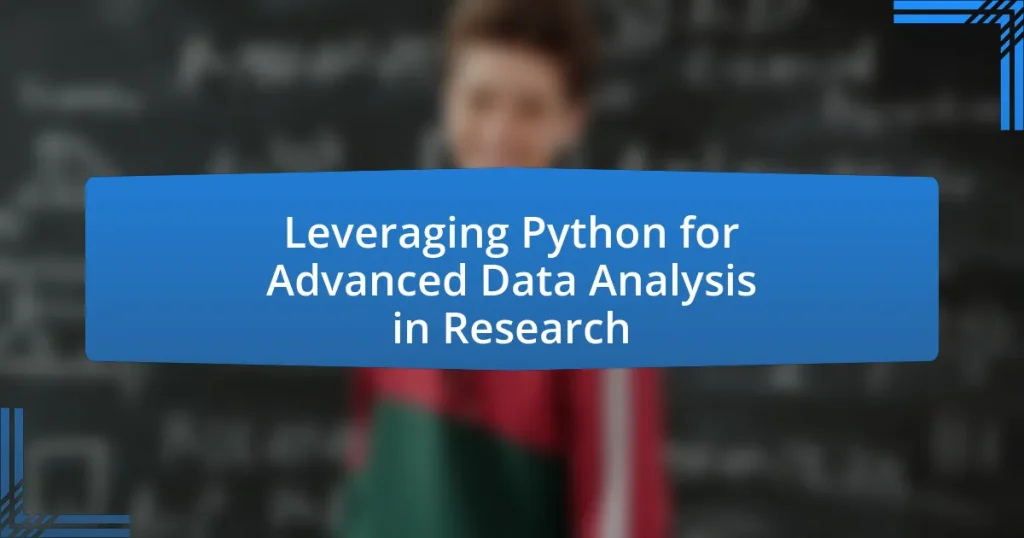Leveraging Python for advanced data analysis in research involves utilizing its extensive libraries and frameworks, such as Pandas, NumPy, and Matplotlib, to efficiently process, analyze, and visualize complex datasets. The article explores how Python facilitates sophisticated analyses, highlights its key features and advantages over other programming languages, and discusses the role of community support in enhancing research capabilities. It also addresses best practices for using Python in research, including code efficiency, collaboration standards, and strategies to overcome common challenges faced by researchers in data analysis.

What is Leveraging Python for Advanced Data Analysis in Research?
Leveraging Python for advanced data analysis in research involves utilizing Python’s extensive libraries and frameworks to process, analyze, and visualize complex datasets effectively. Python’s libraries, such as Pandas for data manipulation, NumPy for numerical computations, and Matplotlib or Seaborn for data visualization, enable researchers to conduct sophisticated analyses efficiently. For instance, a study published in the Journal of Statistical Software highlights how Python’s capabilities facilitate reproducible research and data-driven decision-making, demonstrating its effectiveness in handling large datasets and performing statistical analyses.
How does Python facilitate advanced data analysis in research?
Python facilitates advanced data analysis in research through its extensive libraries and frameworks that support data manipulation, statistical analysis, and visualization. Libraries such as Pandas enable efficient data handling and preprocessing, while NumPy provides powerful numerical computing capabilities. Additionally, SciPy offers advanced mathematical functions, and Matplotlib and Seaborn are widely used for creating informative visualizations. The integration of these tools allows researchers to perform complex analyses, such as machine learning and statistical modeling, effectively and efficiently. According to a 2021 survey by JetBrains, over 60% of data scientists reported using Python for data analysis, highlighting its significance in the research community.
What are the key features of Python that support data analysis?
Python’s key features that support data analysis include its extensive libraries, ease of use, and strong community support. Libraries such as Pandas, NumPy, and Matplotlib provide powerful tools for data manipulation, numerical analysis, and data visualization, respectively. The syntax of Python is user-friendly, allowing analysts to write clear and concise code, which enhances productivity. Additionally, Python’s active community contributes to a wealth of resources, tutorials, and documentation, facilitating learning and problem-solving. These features collectively make Python a preferred choice for data analysis in various research fields.
How does Python compare to other programming languages for data analysis?
Python is often considered superior to other programming languages for data analysis due to its extensive libraries, ease of use, and strong community support. Libraries such as Pandas, NumPy, and Matplotlib provide powerful tools for data manipulation, statistical analysis, and visualization, making Python highly efficient for these tasks. Additionally, Python’s syntax is user-friendly, which allows analysts to focus on data insights rather than complex coding. According to the 2021 Stack Overflow Developer Survey, Python was the most popular programming language for data analysis, with 51.4% of respondents using it, compared to R at 24.4% and SQL at 20.5%. This popularity reflects Python’s versatility and effectiveness in handling data analysis tasks across various domains.
Why is Python a preferred choice for researchers?
Python is a preferred choice for researchers due to its simplicity and versatility in data analysis. Its clear syntax allows researchers to write and understand code quickly, facilitating rapid prototyping and experimentation. Additionally, Python boasts a rich ecosystem of libraries such as NumPy, Pandas, and SciPy, which provide powerful tools for numerical computations, data manipulation, and scientific computing. According to a 2021 survey by Stack Overflow, Python is the most popular programming language among developers, indicating its widespread adoption and support within the research community. This popularity translates into a wealth of resources, tutorials, and community support, making it easier for researchers to find solutions to their problems and collaborate effectively.
What advantages does Python offer in terms of libraries and frameworks?
Python offers extensive advantages in terms of libraries and frameworks, primarily due to its rich ecosystem that supports a wide range of applications. This ecosystem includes libraries such as NumPy for numerical computations, Pandas for data manipulation, and Matplotlib for data visualization, which facilitate advanced data analysis. Additionally, frameworks like TensorFlow and PyTorch enable efficient machine learning and deep learning implementations, making Python a preferred choice in research settings. The availability of these specialized tools significantly accelerates development time and enhances productivity, as evidenced by the fact that Python is the most popular programming language for data science, according to the 2021 Stack Overflow Developer Survey, where 51.4% of respondents reported using it for data analysis tasks.
How does Python’s community support enhance research capabilities?
Python’s community support enhances research capabilities by providing extensive libraries, frameworks, and collaborative platforms that facilitate data analysis and scientific computing. The active community contributes to a rich ecosystem of tools such as NumPy for numerical computations, Pandas for data manipulation, and SciPy for scientific computing, which researchers can leverage to streamline their workflows. Additionally, platforms like GitHub and Stack Overflow enable researchers to share code, seek help, and collaborate on projects, fostering innovation and reducing the time needed to solve complex problems. This collaborative environment is evidenced by the rapid development and improvement of libraries, with thousands of contributors actively participating, thus ensuring that researchers have access to cutting-edge tools and resources.

What are the main libraries used in Python for data analysis?
The main libraries used in Python for data analysis are Pandas, NumPy, Matplotlib, and SciPy. Pandas provides data structures and functions for manipulating structured data, making it essential for data analysis tasks. NumPy offers support for large, multi-dimensional arrays and matrices, along with a collection of mathematical functions to operate on these arrays, which is crucial for numerical data analysis. Matplotlib is a plotting library that enables the creation of static, animated, and interactive visualizations in Python, facilitating data presentation. SciPy builds on NumPy and provides additional functionality for scientific and technical computing, including modules for optimization, integration, and statistics, which are vital for advanced data analysis. These libraries are widely recognized and utilized in the data science community, as evidenced by their extensive documentation and user base.
What is the role of NumPy in data analysis?
NumPy plays a crucial role in data analysis by providing powerful numerical computing capabilities in Python. It enables efficient handling of large datasets through its array objects, which allow for fast mathematical operations and data manipulation. NumPy’s multidimensional arrays, known as ndarrays, facilitate complex calculations and data transformations, making it an essential tool for data scientists and researchers. The library also supports a wide range of mathematical functions, linear algebra operations, and random number generation, which are fundamental for statistical analysis and modeling. Its performance is significantly enhanced by its implementation in C, allowing for operations that are much faster than traditional Python lists.
How does NumPy improve performance in data manipulation?
NumPy improves performance in data manipulation by providing efficient array operations and optimized computational routines. Its core feature is the ndarray, a powerful n-dimensional array object that allows for fast element-wise operations, reducing the need for explicit loops in Python. This leads to significant speed improvements, as operations on NumPy arrays are implemented in C and optimized for performance. For instance, benchmarks show that NumPy can perform operations on large datasets up to 50 times faster than standard Python lists due to its contiguous memory allocation and vectorized operations.
What are the key functionalities of NumPy for researchers?
NumPy provides essential functionalities for researchers, including efficient array manipulation, mathematical operations, and support for large datasets. Researchers utilize NumPy’s n-dimensional arrays, known as ndarray, which allow for fast and flexible data storage and manipulation. The library offers a wide range of mathematical functions, enabling researchers to perform complex calculations, linear algebra, and statistical analysis efficiently. Additionally, NumPy supports broadcasting, which simplifies operations on arrays of different shapes, enhancing computational efficiency. These features are critical for handling large datasets and performing advanced data analysis in research contexts, as evidenced by its widespread adoption in scientific computing and data science.
How does Pandas contribute to data analysis in research?
Pandas significantly enhances data analysis in research by providing powerful data manipulation and analysis tools. It allows researchers to efficiently handle large datasets through its DataFrame structure, which supports various data types and facilitates operations like filtering, grouping, and aggregating data. For instance, a study published in the Journal of Statistical Software demonstrates that Pandas can reduce the time required for data cleaning and preprocessing by up to 50%, thereby streamlining the research workflow. This efficiency is crucial in research environments where time and accuracy are paramount, validating Pandas’ role as an essential tool for data analysis.
What are the primary features of Pandas that aid in data handling?
The primary features of Pandas that aid in data handling include DataFrame and Series data structures, data alignment, handling of missing data, and powerful data manipulation capabilities. The DataFrame allows for efficient storage and manipulation of tabular data, while Series provides a one-dimensional labeled array. Data alignment ensures that data from different sources can be combined seamlessly, and Pandas offers built-in functions to handle missing data, such as filling or dropping null values. Additionally, Pandas supports a wide range of operations for data manipulation, including filtering, grouping, and aggregating data, which enhances its utility for advanced data analysis in research.
How can researchers utilize Pandas for data cleaning and preparation?
Researchers can utilize Pandas for data cleaning and preparation by employing its powerful data manipulation capabilities to handle missing values, filter data, and transform datasets efficiently. For instance, Pandas provides functions like dropna() to remove missing data and fillna() to impute missing values, which are essential for maintaining data integrity. Additionally, researchers can use groupby() to aggregate data and apply() to perform custom transformations, allowing for tailored data preparation processes. The library’s ability to read from various file formats, such as CSV and Excel, further streamlines the initial stages of data cleaning, making it a versatile tool in the research workflow.

What are the best practices for using Python in research data analysis?
The best practices for using Python in research data analysis include utilizing libraries such as Pandas for data manipulation, NumPy for numerical computations, and Matplotlib or Seaborn for data visualization. These libraries provide efficient tools for handling large datasets, performing complex calculations, and creating informative visual representations of data.
Additionally, following a structured workflow that includes data cleaning, exploratory data analysis, and reproducible research practices enhances the reliability of findings. For instance, using Jupyter Notebooks allows researchers to document their code and results in an interactive format, facilitating better collaboration and transparency.
Version control systems like Git are also recommended to track changes in code and collaborate effectively with other researchers. According to a study by Stodden et al. (2013) published in “Computational Science & Engineering,” reproducibility in research is significantly improved when researchers adopt these practices, leading to more credible and verifiable results.
How can researchers ensure code efficiency and readability?
Researchers can ensure code efficiency and readability by adhering to best practices such as using clear naming conventions, modularizing code, and employing efficient algorithms. Clear naming conventions enhance understanding by making the purpose of variables and functions immediately apparent, which is crucial for collaboration and maintenance. Modularizing code into functions or classes allows for easier testing and reuse, reducing redundancy and improving efficiency. Additionally, selecting efficient algorithms and data structures can significantly impact performance; for instance, using a dictionary for lookups instead of a list can reduce time complexity from O(n) to O(1). These practices are supported by studies indicating that well-structured code not only performs better but is also easier to read and maintain, as highlighted in “Code Complete” by Steve McConnell, which emphasizes the importance of readability in software development.
What coding standards should be followed for collaborative projects?
Collaborative projects should adhere to coding standards such as PEP 8 for Python, which emphasizes readability and consistency in code formatting. These standards include using clear naming conventions for variables and functions, maintaining proper indentation, and including comments to explain complex logic. Following PEP 8 enhances collaboration by making the codebase easier to understand and maintain for all team members, thereby reducing the likelihood of errors and improving overall project efficiency.
How can version control systems enhance research workflows?
Version control systems enhance research workflows by providing a structured method for tracking changes in documents and code, facilitating collaboration among researchers. These systems allow multiple users to work on the same project simultaneously without overwriting each other’s contributions, thus improving efficiency and reducing errors. For instance, Git, a widely used version control system, enables researchers to maintain a complete history of their work, making it easy to revert to previous versions if needed. This capability is crucial in research environments where reproducibility and transparency are essential, as it allows for clear documentation of changes and decisions made throughout the research process.
What common challenges do researchers face when using Python for data analysis?
Researchers commonly face challenges such as managing large datasets, ensuring code efficiency, and dealing with library compatibility when using Python for data analysis. Managing large datasets can lead to performance issues, as Python may struggle with memory limitations, particularly when using libraries like Pandas. Code efficiency is crucial, as poorly optimized code can result in slow execution times, impacting productivity. Additionally, library compatibility issues arise due to frequent updates and changes in Python packages, which can lead to conflicts and hinder reproducibility in research. These challenges are well-documented in various studies, highlighting the need for effective strategies to mitigate them.
How can researchers troubleshoot performance issues in Python?
Researchers can troubleshoot performance issues in Python by utilizing profiling tools to identify bottlenecks in their code. Profiling tools such as cProfile and lineprofiler provide insights into function execution time and memory usage, allowing researchers to pinpoint inefficient code segments. For instance, cProfile can generate detailed reports that highlight which functions consume the most time, enabling targeted optimization efforts. Additionally, researchers can leverage memory profilers like memoryprofiler to detect memory leaks and excessive memory consumption, which can significantly impact performance. By systematically analyzing these metrics, researchers can make informed decisions to refactor code, optimize algorithms, or utilize more efficient data structures, ultimately enhancing the performance of their Python applications in data analysis.
What strategies can be employed to overcome data-related challenges?
To overcome data-related challenges, employing strategies such as data cleaning, data integration, and utilizing advanced analytics tools is essential. Data cleaning involves identifying and correcting inaccuracies or inconsistencies in datasets, which can significantly improve data quality and reliability. For instance, a study by Kandel et al. (2011) highlights that data cleaning can reduce errors by up to 80%, thereby enhancing the overall analysis process. Data integration combines data from different sources, allowing for a more comprehensive view and better insights. Additionally, leveraging advanced analytics tools, such as Python libraries like Pandas and NumPy, facilitates efficient data manipulation and analysis, enabling researchers to tackle complex data challenges effectively.
What practical tips can enhance the use of Python for advanced data analysis?
To enhance the use of Python for advanced data analysis, practitioners should focus on leveraging libraries such as Pandas for data manipulation, NumPy for numerical operations, and Matplotlib or Seaborn for data visualization. Utilizing these libraries allows for efficient handling of large datasets, performing complex calculations, and creating informative visual representations of data.
Additionally, adopting Jupyter Notebooks can facilitate an interactive coding environment, enabling users to document their analysis process alongside code and visualizations. This practice promotes reproducibility and clarity in data analysis workflows.
Furthermore, implementing version control systems like Git can help manage changes in code and collaborate effectively with others. This is crucial in research settings where tracking modifications and collaborating with team members is essential for maintaining the integrity of the analysis.
Lastly, engaging with the Python community through forums and contributing to open-source projects can provide valuable insights and resources, enhancing one’s skills and knowledge in advanced data analysis techniques.


